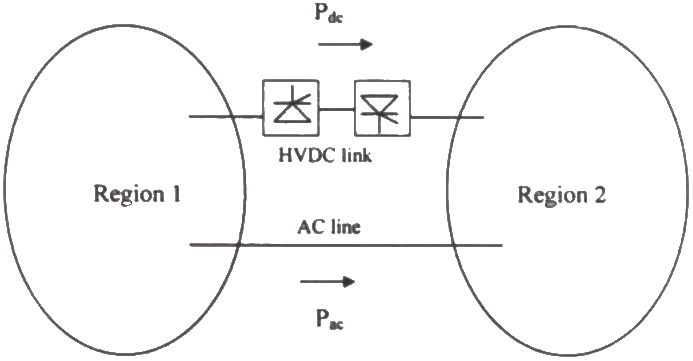Previous Year Questions- High Voltage DC Transmission | Power Systems - Electrical Engineering (EE) PDF Download
Q1: Power is transferred from system A to system B by an HVDC link as shown in the figure. If the voltage VAB and VCD are as indicated in figure, and I > 0, then (2010) (a) VAB < 0, VCD < 0, VAB > VCD
(a) VAB < 0, VCD < 0, VAB > VCD
(b) VAB > 0, VCD > 0, VAB < VCD
(c) VAB > 0, VCD > 0, VAB > VCD
(d) VAB > 0, VCD < 0,
Ans: (c)
Sol: Power flows in the indicated direction when VAB > 0, VCD > 0 and VAB > VCD
Since current flows high voltage to low voltage.
Q2: Two regional systems, each having several synchronous generators and loads are inter connected by an ac line and a HVDC link as shown in the figure. Which of the following statements is true in the steady state : (2007) (a) Both regions need not have the same frequency
(a) Both regions need not have the same frequency
(b) The total power flow between the regions (Pac+Pdc) can be changed by controlled the HDVC converters alone
(c) The power sharing between the ac line and the HVDC link can be changed by controlling the HDVC converters alone.
(d) The directions of power flow in the HVDC link (Pdc) cannot be reversed
Ans: (c)
Sol: Both region are connected by HVDC link as well as AC line. So AC link is possible when both regions have frequency.
By changing fringe angle (α) of converter, we can change the power sharing, between the AC line and HVDC link.
Q3: An HVDC link consist of rectifier, inverter transmission line and other equipments. Which one of the following is true for this link ? (2006)
(a) The transmission line produces/ supplies reactive power
(b) The rectifier consumes reactive power and the inverter supplies reactive power from/ to the respective connected AC systems
(c) Rectifier supplies reactive power and the inverted consumers reactive power to/ from the respective connected AC systems
(d) Both the converters (rectifier and inverter) consume reactive power from the respective connected AC systems
Ans: (b)
Sol: The rectifier consumes reactive power and inverter supplies reactive power from/to the respective connected AC systems because no reactive power can be transmitted over a dc link.
Q4: High Voltage DC (HVDC) transmission is mainly used for (2005)
(a) bulk power transmission over very long distances
(b) inter-connecting two systems with same nominal frequency
(c) eliminating reactive power requirement in the operation
(d) minimizing harmonics at the converter stations
Ans: (a)
Sol: HVDC system are economical for long distance bulk power transmission by overhead lines, due to reduced power and cable costs.
The DC line is an asynchronous link and it can interconnect two rigid systems operating at different frequencies.
Converters and converter transformers requires reactive power in the operation.
The AC/DC converters are sources of harmonics on AC as well as DC side.
Q5: Choose two appropriate auxiliary components of a HVDC transmission system from the following (2003)
P. D.C line inductor
Q. A.C line inductor
R. Reactive power sources
S. Distance relays on D.C line
T. Series capacitance on A.C. line
(a) P and Q
(b) P and R
(c) Q and S
(d) S and T
Ans: (b)
Sol: D.C. line inductor, reduce the harmonic current in the DC line and possible transient over currents.
Converters and converter transformers consume reactive power.
The reactive power may be supplied from
(i) AC filter
(ii) Shunt Capacitor
(iii) AC Network
(iv) Static compensators
(v) Synchronous condensers.
|
30 videos|101 docs|45 tests
|















